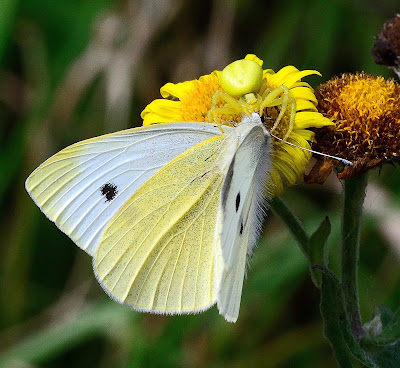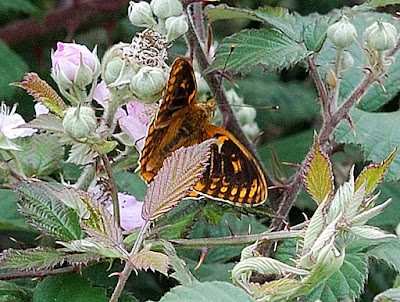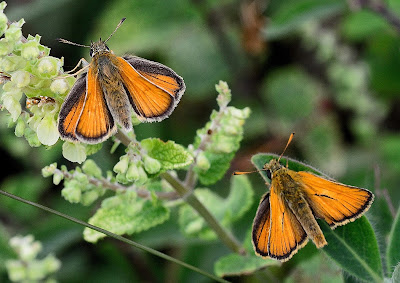In the top corner of a sheltered window frame on the outside of our house is a Large White pupa or chrysalis.It will remain there for up to eight months until the arrival of spring.The chrysalis is secured by a silken pad and girdle, and its colour can depend on its surroundings. Length is 25mm.
Wednesday 9 December 2015
Sunday 15 November 2015
Top Highlight of 2015.
The past season has thrown up several exciting sightings, such as the close encounter with White-letter Hairstreaks on an elm in Newport town centre,the joy of seeing the valezina form of the Silver-washed Fritillary in numbers at Porchfield,and finding a colony of Lesser Spotted Fritillaries on the beach on the Greek Island of Thassos. However the best must be the discovery of Glanville Fritillary pupae or chrysalies on the Island back in May.Here the habitat for this fritillary is unique as the continental Glanvilles frequent meadows,riverbanks,and woodland clearings.On the Isle of Wight it is a butterfly of our cliffs and clifftops.Therefore finding a spot to pupate can mean under stones or rocks and this is the place where these chrysalises were found.As normal they use a strand of silk to attach themselves to their chosen stone where it will take up to three weeks to emerge as an imago.
Thursday 8 October 2015
A Small Copper in the Sun.
Today on a sunny bank along the cliff top at Compton Chine was a Small Copper.She was busily egg laying on a warm afternoon now that the wind of the last few days had abated.Not many butterflies to see however on the landslip apart from a single Large White and a couple of Clouded Yellows.
Monday 7 September 2015
Adonis on Bonchurch Down.
With the prospect of several days of settled sunny weather there was no better time to take a walk on Bonchurch Down to see the Adonis Blue.It seems numbers are less than other years so counts are in tens rather than hundreds. Nevertheless it was a joy to see this most brilliant butterfly on the wing feeding on downland flowers and flying strongly on the Downs' slopes.That is,of course the males as they display those sky blue wings.The females are altogether different with brown wings,although sometimes they show variable amounts of blue.

Friday 4 September 2015
Sky Blue Adonis Blue.
A long overdue visit to Wheelers Bay at Bonchurch yesterday discovered some late summer colour behind the revetment at the base of the cliffs.Several species of butterfly were feeding on the ample drifts of Red Valerian and other flowering plants. Among them, a single male Adonis Blue splendid in striking sky blue. August and September is the time of the Adonis Blue second emergence of the season on our downland,so this individual is some distance away from his usual habitat on Bonchurch Down.
Tuesday 1 September 2015
A Small White and a Small Yellow.
This Small White has fallen prey to a Crab Spider.There is just one species of this spider in the UK apparently belonging the genus Misumena. The spider has the ability to change colour from white,to pale green,and yellow.This allows the spider to match its background, as it sits motionless on a flower bloom awaiting a victim which it pounces on and grasps with its crab-like front legs.

Saturday 22 August 2015
A Magnificent Moth.
Although very common in the UK especially in the south of England,the Oak Eggar is a great sight to see and a magnificent moth.This female was attracted by our house lights.The male which is slightly darker in colour and smaller is generally a daytime flyer and searches for resting females. The female emerges at dusk and flies at night.
Tuesday 18 August 2015
Lesser,But No Less Delightful.
The spectacular beach of Chrissi Ammoudia, or Golden Beach as it is known to tourists on the North Aegean Island of Thassos,Greece is a three kilometre stretch of sand backed by a fertile plain and high hills and mountains.My first visit to this now popular holiday destination was in 1991 when the beach was devoid of loungers and umbrellas and many streams flowed across the reedy and olive grove farmland to the sea.A tourist explosion hit this extensive bay, leading to the development of the new holiday village of Scala Panagia at the northern end of the beach and the building of tourist apartments all along the bay inland of the beach.This was clear on my second visit in 2012,so I was ready for more of the same on this years trip.Thankfully building has not taken place near to the waters edge and therefore the dunes still separate the beach from the holiday apartments.
In these dunes can still be found butterflies and other insects and a good find this time was the small but lovely Lesser Spotted Fritillary.It is not as common as its larger relative,the Spotted Fritillary,but is no less colourful.The sexes are similar in size and colouration as they fly around low to the sand from seed head to seed head.
Thursday 30 July 2015
Something New,Something Blue.
With a report of a probable second brood of Small Blue at a nearby established colony a few days ago,I was at last able to take a look for our smallest butterfly.The weather has been very changeable over recent days but thankfully today the strong wind had abated and we enjoyed some warm sunny periods.It was not long before I came across two mating pairs and although Small Blue colonies tend to be fairly small ,such as this particular one,hopefully a few more butterflies will emerge.
The flight period is from May to late June with an occasional second brood in late July and August.At this location however it is normal for this species to appear in April.
Sunday 26 July 2015
Back to Normal.
The Silver-washed Fritillary is a majestic butterfly of our woodlands in the summer months.The male is a strong flyer along our woodland glades stopping on feed at bramble flowers. The female on the other hand can sometimes be seen flying in the shade of oak trees seeking a suitable place to lay her eggs at the base of the tree.
As they mature the female Silver-washed develop a slight green tinge to their upper wings.This can vary intensity and the female pictured below has a significant greening of her wings.Unlike the valezina form it does not extend to all the upper side.
 |
| Male Silver-washed. |
Saturday 25 July 2015
On the Lookout for Something Special.
In the south of England including the Isle of Wight up to 15% of female Silver-washed Fritillaries occur in the beautiful form of valezina. These females are olive-green in colour with an underside of washed pink.This individual pictured below was spotted today in a nearby copse enjoying the ample bramble flowers.
Thursday 23 July 2015
Pretty as a Picture.
The Painted Lady is a regular visitor to the UK although numbers vary greatly from year to year.We can have several broods during the course of the summer and there cannot be a more pleasant sight than a freshly emerged Painted Lady enjoying the sunshine and feeding in a warm flowery location.Therefore today in my local wood it was lovely to see several individuals on bramble and thistle flowers.
Thursday 16 July 2015
The First of Many.
The Chalk-hill Blue can be very prolific on our chalk downland from mid-July to September.A walk along the bridleway to West High Down this afternoon produced a good variety of butterflies but no Chalk-hill Blues.Even on the Down and despite the abundant flowering plants, no Blues.So I had almost resigned myself to another visit in a day or two when returning from the Down along the bridleway the beautiful silvery-blue of a male Chalk-hill in flight caught my eye.He was flying strongly over the drifts of Hemp-agrimony that are just bursting into flower and a definite favourite with many butterflies.
Thursday 9 July 2015
Back on the Downs.
Since my last walk up to West High Down a few days ago the Giant Thistles are now in bloom and attracting a myriad of butterflies,bees,and other insects.Happily,among them are the Dark Green Fritillaries.The promise of rich nectar has slowed them down and they can be observed a little better, now that they are stationary for a few seconds.
With the flush of new flowering plants there is an increase in butterflies especially the Small Skipper.
Wednesday 8 July 2015
That Looks Unusual....
It is always worth taking a closer look at even the common butterflies when out and about.There is a chance that you may be fortunate enough to come across an unusual individual or more correctly an aberration.Most species it seems are prone to aberration and some forms of aberration are classified, but then again many are listed as unclassified.
For a comprehensive list and extensive information on recognized aberrations I would recommend a visit to the excellent website British Butterfly Aberrations.
 |
| Red Admiral ab.bialbata. White spot on red band. |
| A Glanville Fritillary with more black than normal on upper hind wings |
 |
| A Meadow Brown displaying loss of colour over much of its hind wing |
 |
| A Dark Green Fritillary with extensive black on its upper wings. |
Friday 3 July 2015
A Red-letter Day.
The White-letter Hairstreak is a secretive butterfly and relies on the elm tree for its life cycle.Therefore disaster struck when in the 1970s Dutch Elm Disease decimated millions of British elms.Fortunately,the caterpillar can survive on new sucker growth and their recovery has been helped too by the dedicated work of local wildlife and butterfly conservation volunteers who have planted disease resistant elms.
So it was a great day today when I had the opportunity, for the first time, to see these lovely little butterflies.An eagle-eyed friend of mine had seen butterfly activity around such a resistant elm and as they tend to spend much of their time towards the top of the tree obtaining good views of this Hairstreak is difficult.However my luck was in today as several individuals descended to the lower branches to seemingly investigate the elm tree buds.
Tuesday 30 June 2015
Up on the Downs.
On the chalk downs that overlook our south-west coastal stretch there are several species of butterfly that find this habitat to their liking.One such species is the Dark Green Fritillary and now is the time to see the first individuals.This morning I could see them as they rushed around at great speed on the hunt for nectar-rich flowers.One of their favourite plants is the giant thistle although at present there seem to be very few in flower.As they are very partial to this thistle it will be perhaps the best way to get a good look at these fast fliers
Monday 29 June 2015
It's Hotting Up.
With the promise of a heatwave this week the weather today was warm and sunny,and just right to prepare us for soaring temperatures by Wednesday.The butterflies certainly responded to the heat and there were plenty to see in my local copse.From just one Silver-washed Fritillary at the weekend,their numbers had increased to at least six.Also on show are the first White Admirals on the season and whereas the Fritillaries are happy to feed on the bramble and thistle flowers,the Admirals prefer at present to fly around the trees only occasionally coming down to land on the sunny spot.
More Marbled Whites are now in the wood and a real treat was to see a female Purple Hairstreak leave the upper branches of an oak tree to bask in the sun almost at ground level.Many thanks to Andy Butler for the use of his photograph of this hairstreak.
Saturday 27 June 2015
Not Just Another Brown.
Butterfly sightings were somewhat disappointing today along my local forest rides.Plenty of Meadow Browns and Speckled Woods but none of the larger woodland butterflies to see.However the Ringlet is now fluttering about and when in the company of the Meadow Browns it can be tricky to separate the two. In flight the upperside of the Ringlet is a tasty chocolate brown whereas the Meadow Brown is a lighter brown.The Ringlet has no orange on the underside unlike the Brown,just a collection of attractive tri-coloured rings.
Subscribe to:
Posts (Atom)




































